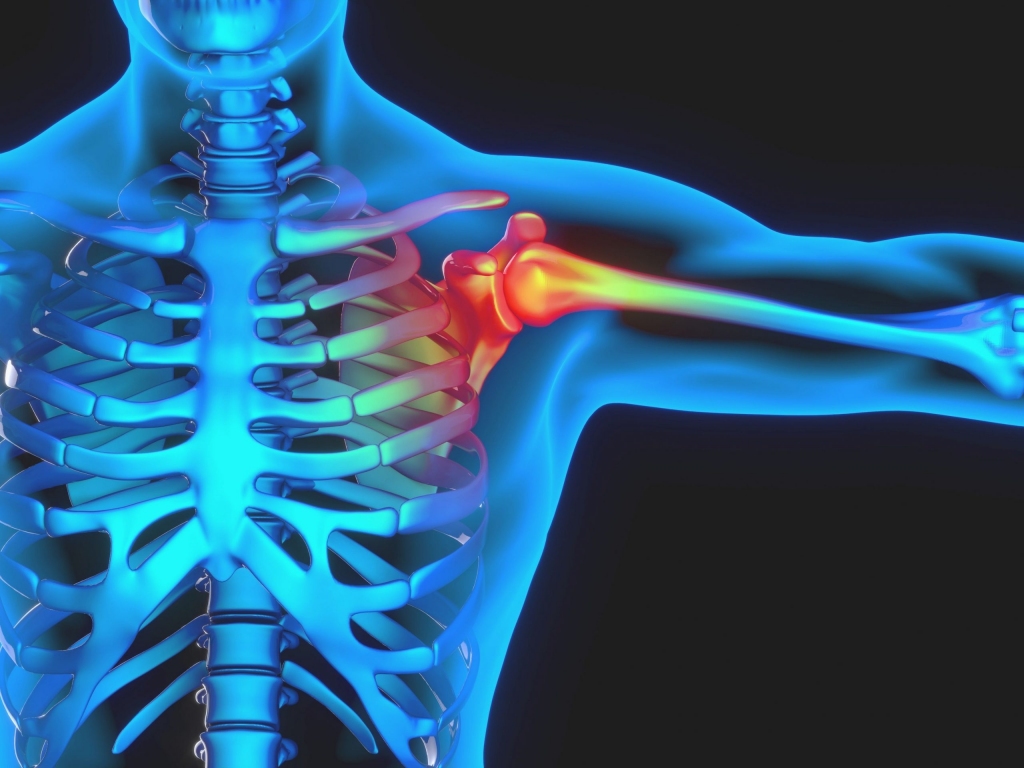102Views 0Comments

The upper arm bone (humerus) and shoulder blade (scapula) are joined by the shoulder joint, which is a ball-and-socket joint. The body’s most movable joint, it supports a variety of motions including flexion, extension, abduction, adduction, and rotation.
The shallow scapular socket known as the glenoid fossa and the head of the humerus combine to produce the ball-and-socket joint. A joint capsule encloses the joint and contains synovial fluid to lubricate and hydrate the joint. The joint capsule is a sleeve of connective tissue.
The humerus is connected to the scapula by a set of muscles and tendons called the rotator cuff, which also stabilises the joint. The supraspinatus, infraspinatus, teres minor, and subscapularis are the muscles that make up the rotator cuff.
The roof of the shoulder joint is formed by the acromion, a bony protrusion of the scapula. The rotator cuff tendons are located in the subacromial area, which is the region between the acromion and the head of the humerus. The bursa, a little sac filled with fluid that cushions the tendons and decreases friction, is also located here.
The coracohumeral ligament, glenohumeral ligaments, and coracoacromial ligament are only a few of the ligaments that support the shoulder joint. Further aiding in joint stabilisation is the biceps tendon, which connects the biceps muscle to the shoulder.
In general, the shoulder joint, which is vital for many daily activities, is a complicated and highly mobile joint. Due to its distinct anatomy and structure, the shoulder is more prone to damage, but most injuries may be adequately treated with the right care and therapy.

The anatomy and function of the shoulder joint are special, making it vulnerable to injury.
First off, the shoulder joint is a ball and socket joint, permitting a large range of motion in several directions. But because it lacks the stability of other joints like the hip, it is also more prone to injury.
Second, a complex web of muscles, tendons, and ligaments surrounds the shoulder joint, supporting and stabilising it. Nevertheless, overuse, trauma, or degenerative changes can very easily harm these soft tissues.
Thirdly,, lifting, reaching, and throwing are just a few of the daily tasks that require the shoulder joint. This increases its susceptibility to repetitive stress problems such shoulder impingement or rotator cuff tears.
Last but not least, there is a relatively low blood supply to the shoulder joint, which can make it more difficult for wounds to heal and raise the risk of consequences like frozen shoulder or avascular necrosis (death of bone tissue due to lack of blood supply).
The shoulder joint is more prone to injury as a result of its particular anatomy, intricate soft tissue structures, regular use, and inadequate blood supply.
Many common shoulder injuries include the following:
- Rotator cuff injury: An injury to the rotator cuff, a set of muscles and tendons that connects the shoulder blade to the upper arm bone, results in a tear of one of its tendons or muscles. The shoulder may experience pain and weakening as a result.
- Shoulder impingement: When the tendons of the rotator cuff are compressed or pinched between the bones of the shoulder, it results in shoulder impingement. The shoulder may experience pain and weakening as a result.
- The upper arm bone coming out of the shoulder socket is known as a shoulder dislocation. The shoulder may experience discomfort, weakness, and instability as a result.
- Shoulder bursitis: Shoulder bursitis is an inflammation of the bursa, a little sac filled with fluid in the shoulder. This may result in shoulder discomfort, swelliness, and restricted range of motion.
- Adhesive capsulitis, another name for frozen shoulder, is a painful and stiffening of the shoulder joint that makes it difficult to move. Injury, surgery, or a medical condition like diabetes are all potential causes of this.
- SLAP tear: superior labral anterior to posterior (SLAP) ,Repetitive overhead motions or trauma can cause a SLAP tear, an injury to the labrum, the cartilage that covers the shoulder socket. The shoulder may experience pain and instability as a result.
- fracture: A fall or other trauma can cause a fracture or broken bone in the shoulder. This may result in shoulder discomfort, swelliness, and restricted range of motion.

How to prevent these injuries-
The following advice will help you avoid shoulder joint injuries:
- Before engaging in any physical activity, it is important to properly warm up. This can assist to boost blood flow to the muscles and get them ready for action, which lowers the risk of injury.
- Muscles surrounding the shoulder should be strengthened since doing so can help to increase the stability of the shoulder joint and lower the risk of injury. Exercises for external and internal rotation that target the rotator cuff muscles can be particularly beneficial.
- While lifting or performing overhead tasks, use good technique: Inappropriate technique can put too much tension on the shoulder joint, which can cause damage. Avoid lifting anything that is excessively heavy for you, and always lift with your legs rather than your back.
- Take breaks and rest when necessary because injury risk can be increased by repetitive stress and overuse. Resting the muscles and joints when taking breaks can aid in injury prevention and healing.
- Keep proper posture. Injury can result from poor posture, which puts additional strain on the shoulder’s muscles and joints. Injury risk can be lowered by maintaining proper posture while moving about and whether sitting or standing.
- Avoid quick, rapid motions since they put too much strain on the shoulder joint and raise the chance of injury. Steady, methodical movement is preferred over rapid movements.
- Get regular exercise and keep a healthy weight: By enhancing general fitness and easing stress on the joints, frequent exercise and maintaining a healthy weight can assist to lower the chance of injury.

These suggestions can help you maintain healthy, pain-free shoulders and prevent injuries to the shoulder joints.


